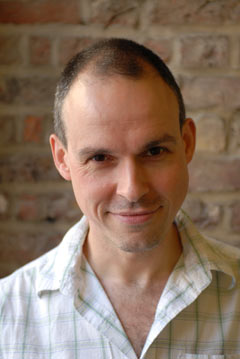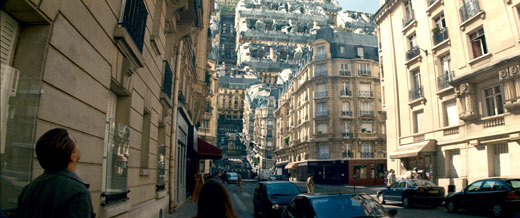On Glaciers, Photorealism, and Something New Under the Sun


F&V: You got your start in animation in the early 1990s at videogame developer Psygnosis (now Sony Computer Equipment’s Studio Liverpool). What did you learn there, and how did that affect your career?
I was a big gamer myself. I come from the North of England, near Manchester. I graduated in 1989 and did a couple of jobs as a videotape editor, but I wanted to get into computer graphics and animation. I saw this job ad and I didn’t realize Psygnosis were in the Northwest, in Liverpool, very close to where I grew up. I thought, “Fantastic – the most interesting games company I can think of is on my doorstep!” We had a very talented software development team that didn’t respect any limits imposed on them by the software packages or even the hardware manufacturers. They would take it apart and rebuild it to do the things they wanted to do. It was a fantastic way to work and very important to me, even now. In VFX, there’s a sense of being constrained by what the software offers you. If you just use the defaults, you’re going with what some engineer at a software company thought was the appropriate way to create a certain effect. It can have a generic, predetermined look. At Psygnosis, the idea was, “No – take it apart, rebuild it, make it your own.”
F&V: As a VFX guy, did you ever consider moving to the U.S.?
I always thought I would. Back in the early 1990s, if you wanted to work in a VFX facility, you tried to get yourself a job at ILM or Digital Domain or Sony and you moved to California. When I was working at Moving Picture Company, which was a television-led operation at the time, I was lucky that I met a group of like-minded people who all wanted to make high-end visual effects for feature films. Polygram Filmed Entertainment backed us to start Double Negative in 1998. There were 10 of us to begin with, and it grew to about 30 to 40 people. We got our start doing creature work on Pitch Black, and Double Negative grew with my ambitions and my career. With each passing year it, becomes less and less necessary for me to move off to the United States.
The first thing we had to establish, straightaway, was whether Chris wanted to take any stylistic approach to the dreams. Would there be any treatment to let us know we were in a dream world? Would the worlds become weirder as we went deeper into them, becoming more psychologically significant? The answer was no. Chris was adamant that he wanted all the levels of dreams to look like we just went out and shot it for real. When the film starts and the audience doesn’t know they’re in a dream, they’re in the same position as one of Dom Cobb’s marks. A lurid color palette or a painterly look – we didn’t want any of that. We wanted it to be akin to a lucid dream. It feels like it’s reality, but you begin to realize you’re in a dream and you can change the nature of the dream. That’s where Chris got his initial ideas from.
When we wanted to have surreal dream moments, we wanted really unique, strong ideas, not ideas borrowed from other fantasy films. Inception has the trappings of a science-fiction film, but Chris wanted it to feel very contemporary and relevant to the world we live in. The fantasy moments, things like Paris folding up, are simple but strong conceptual ideas. But if there’s something strange with the landscape of Paris, or the tricks we play with mirrors on the bridge, the audience starts looking for the join between reality and digital. If anything, that put more scrutiny on our work and pushed us harder to get the look right.
The philosophy of keeping it real extends to another part of the approach, which was to try and do as much of it for real as possible. A great example of that is the absolutely astonishing special-effects work of [special-effects supervisor] Chris Corbould’s team. The hotel corridor set involves wire work in zero gravity. Digital visual effects complete the work, but the driving physical component behind it is a gag we’re doing on set. That gives it a unique texture. We wanted you to imagine yourself spiraling down that corridor, and if we went too surreal or too fantastic, that would be a barrier.
F&V: Do you think Christopher Nolan’s push toward more naturalistic VFX work is becoming influential on other filmmakers?
It’s more of a general move toward photorealism in VFX work, driven by advances in the technique. People are getting better and better at it. Batman Begins showed that you can take a very naturalistic approach to an outrageous concept, presenting it in a gritty and realistic fashion. On Inception, there were advances in how we handled color space in the filmed image that lets us get closer to the look of camera negative in our VFX work than before. It’s interesting – you see more and more in the press about how a filmmaker did something “without recourse to digital VFX or CGI,” and VFX people say, “Well, I know it’s loaded with VFX because I made this film.” It’s more about filmmaking, not about showing off a digital technique. Some people say, “Don’t you feel hard done by not being recognized for the work?” No, I don’t. First and foremost, I look at myself as a filmmaker. I just use computers to do a lot of my filmmaking.

F&V: What was the hardest shot, or part of a shot, in Inception?
That’s one I’ve been asked a few times. It’s a difficult question to answer. Everything is hard, because Chris demands higher standards. Sticking in exterior green-screens in the windows of the bullet train at the beginning of the film or inside of the helicopter, when Leonardo [DiCaprio] and Joseph Gordon-Levitt take the ride with Ken Watanabe’s character, Saito. Those scenes will be subjected to an amazing level of scrutiny to make sure the movement outside is correct and the line of the horizon is exactly right and the exposure levels are exactly right. It has to look absolutely photographic. For me, from a pure heavy-lifting point of view, folding up Paris was a very big deal. It was a startlingly real and unforgiving natural city landscape that we had to create in full daylight. We had to do an extraordinary thing and we had to deliver it early for a trailer that came out before Christmas!
From a technical point of view, the scene of Limbo Beach with the crumbling city collapsing into the sea was extremely challenging. The level of detail in the cityscape – there were no repeats in the buildings you see being damaged and crumbling away. Chris had a unique idea that this city represents the decaying state of Cobb’s mind. It’s a mental construct deep down in his subconscious, and he’s returning to it after many years of being away, when he’s beginning to lose track of what’s real and what’s a dream. Chris had this idea of taking a city of early-20th-century buildings and combining them with a natural landform, a glacier or cliff face, to give a sense that the buildings were being squashed together into this big, enormous mass and collapsing into the sea of his subconscious. It was brilliant on the page – a city crumbling into the sea like a glacier – but what does that look like? How do you draw it? Trying to conceptualize it, we never felt we could really go there. It was too conventional a science-fiction fantasy. Instead we took a bold approach to it.
We procedurally designed the city. We built a digital model of a glacier, based on photographs, and developed software that filled the interior volume of the glacier with buildings taken from a library of buildings that we constructed with modern architecture. The software then varied the height of the buildings to match the profile of the glacier and varied the size of the buildings to get smaller steps in the profile curve so we could get more detail. It would look at the way the glacier was chipped and the gullies and ravines in the glacier to get the damage ripped out of the buildings. And there was a host of other things that we added. This represented two or three months of work, constantly cranking out different versions of this model, letting the software decide where to place the buildings and drive the detail and the damage to eventually arrive at this weird, mutant city. During all this time, I hadn’t been able to show Chris anything. It was a unique technical and conceptual challenge, but he was confident in our ability to deliver the scene. He was very supportive, but it was kind of a hard sell to Warner Brothers, who wondered if he was sure this was the right way to go.
I remember showing it to Chris for the first time. We were out on the beach where we were shooting the scene with Leo, washed up in the surf, and I showed him on my laptop. He said, “Well, that looks like something we’ve never seen before.” That’s when I knew we had got it.
Did you enjoy this article? Sign up to receive the StudioDaily Fix eletter containing the latest stories, including news, videos, interviews, reviews and more.










Leave a Reply